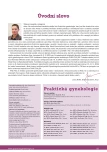-
Medical journals
- Career
Lichen sclerosus.
Authors: M. Pešek; J. Bouda; Z. Rokyta
Authors‘ workplace: Gynekologicko-porodnická klinika LF UK a FN Plzeň
Published in: Prakt Gyn 2009; 13(3): 153-157
Overview
Lichen sclerosus (LS) belongs to frequent non‑neoplastic epithelial disorders of the vulva. Patients suffer with intensive pruritus or dyspareunia. Ethiology of LS is unclear, there is a risk of progressive scarring of external genitalia and patients with LS have increased risk of developing squamous cell carcinoma of the vulva (3–5%). A potent local corticosteroid is a treatment of choice. Frequent reccurences require repeated therapy. A close follow‑up in a 6-months intervals and biopsy of all atypical lesions is required. Surgery is rarely indicated in the management of LS.
Key words:
lichen sclerosus – non‑neoplastic epithelial disorders – clobetazol propionate – tacrolimus
Sources
1. Goldstein AT, Marinoff SC, Christopher K et al. Prevalence of vulvar lichen sclerosus in a general gynecology practice. J Reprod Med 2005; 50(7): 477–480.
2. Meffert JJ, Davis BM, Grimwood RE. Lichen sclerosus. J Am Acad Dermatos 1995; 32(3): 393–416.
3. Powell JJ, Wojnarowska F. Lichen sclerosus. Lancet 1999; 353(9166): 1777–1783.
4. Friedrich EG Jr, Kalra PS. Serum levels of sex hormones in vulvar lichen sclerosus and the effect of topical testosterone. N Engl J Med 1984; 310(8): 488–491.
5. Sideri M, Origoni M, Spinaci L et al. Topical testosterone in the treatment of vulvar lichen sclerosus. Int J Gynaecol Obstet 1994; 46(1): 53–56.
6. Preti M, Micheletti L, Barbero M et al. Psychological distress in women with non‑neoplastic disorders of the vulva. J Reprod Med 1994; 39(12): 961–963.
7. Cooper SM, Gao XH, Powell JJ et al. Does treatment of vulvar lichen sclerosus influence its prognosis? Arch Dermatol 2004; 140(6): 702–706.
8. Leibowitch M, Neill S, Pelisse M et al. The epithelial changes associated with squamous cell carcinoma of the vulva; a review of the clinical, histological and viral findings in 78 women. Br J Obstet Gynaecol 1990; 97(12): 1135–1139.
9. Tan SH, Derrick E, McKee PH et al. Altered p53 expression and epidermal cell proliferation is seen in vulval lichen sclerosus. J Cutan Pathol 1994; 21(4): 319–323.
10. Val I, Almeida G. An overview of lichen sclerosus. Clin Obstet Gynecol 2005; 48(4): 808–817.
11. Ansink AC, Krul MR, De Weger RA et al. Human papillomavirus, lichen sclerosus and squamous cell carcinoma of the vulva: detection and prognostic significance. Gynaecol Oncol 1994; 52(2): 180–184.
12. Raspollini MR, Asirelli G, Moncini D et al. A comparative analysis of lichen sclerosus of the vulva and lichen sclerosus that evolves to vulvar squamous cell carcinoma. Am J Obstet Gynecol 2007; 197(6): 592–595.
13. Farrell AM, Dean D, Wojnarowska F. Vulval lichen sclerosus: a study of its inflammatory infiltrate. Br J Dermatol 1997; 136 : 462. Abstract.
14. Farrell AM, Millard P, Wojnarowska F. An infective aetiology for lichen sclerosus: myth or reality? Br J Dermatol 1997; 137 : 25. Abstract.
15. Marren P, Charnock M, Wojnarowska F et al. The basement membrane zone in lichen sclerosus: an immunohistochemical study. Br J Dermatol 1997; 136(4): 508–514.
16. Marren P, Yell J, Charnock FM et al. The association between lichen sclerosus and antigens of the HLA system. Br J Dermatol 1995; 132(2): 197–203.
17. Powell J, Wojnarowska F, Marren P. Lichen sclerosus autoimmunity and immunogenetics-DQ7 is most associated with onset in females in childhood. Br J Dermatol 1998; 139 : 47.
18. Schempp C, Bocklage H, Lange R et al. Further evidence for Borrelia burgdorferi infection in morphea and lichen sclerosus et atrophicus confirmed by DNA amplification. J Invest Dermatol 1993; 100(5): 717–720.
19. Shelley WB, Shelley ED, Amurao CV. Treatment of lichen sclerosus with antibiotics. Int J Dermatol 2006; 45(9): 1104–1106.
20. Drut RM, Gómez MA, Drut R et al. Human papillomavirus is present in some cases of childhood penile lichen sclerosus: an in situ hybridisation and SP‑PCR study. Pediatr Dermatol 1998; 15(2): 85–90.
21. Bracco GL, Carli P, Sonni L et al. Clinical and histologic effect of topical treatments of vulval lichen sclerosus. A critical evaluation. J Reprod Med 1993; 38(1): 37–40.
22. Smith YR, Quint EH. Clobetasol propionate in the treatment of premenarchal vulvar lichen sclerosus. Obstet Gynecol 2001; 98(4): 588–591.
23. Assmann T, Becker-Wegerich P, Grewe M et al. Tacrolimus ointment for the treatment of vulvar lichen sclerosus. J Am Acad Dermatol 2003; 48(6): 935–937.
24. Kunstfeltd R, Kirnbauer R, Stingl G et al. Successful treatment of vulvar lichen sclerosus with topical tacrolimus. Arch Dermatol 2003; 139(7): 850–852.
25. Böhm M, Frieling U, Luger TA et al. Successful treatment of anogenital lichen sclerosus with topical tacrolimus. Arch Dermatol 2003; 139(7): 922–924.
26. van de Nieuwenhof HP, van der Avoort IA, de Hullu JA. Review of squamous premalignant vulvar lesions. Crit Rev Oncol Hematol 2008; 68(2): 131–156.
27. Bousema MT, Romppanen U, Geiger JM et al. Acitretin in the treatment of severe lichen sclerosus et atrophicus of the vulva; a double blind, placebo-controlled study. J Am Acad Dermatol 1994; 30(2 Pt 1): 225–231.
Labels
Paediatric gynaecology Gynaecology and obstetrics Reproduction medicine
Article was published inPractical Gynecology

2009 Issue 3-
All articles in this issue
- Are the caesarian section and birthweight associated with alergies?
- Screening of disturbances of thyroid gland during pregnancy and postpartum
- Malignant tumors of vulva
- Lichen sclerosus.
- Lymfoedema of the upper extremity after breast cancer therapy.
- Antichlamydial antibodies occurrence in men and women.
- Forensic aspects of assisted reproduction within the legislation context of the Czech and Slovak Republics.
- Practical Gynecology
- Journal archive
- Current issue
- Online only
- About the journal
Most read in this issue- Lichen sclerosus.
- Malignant tumors of vulva
- Screening of disturbances of thyroid gland during pregnancy and postpartum
- Forensic aspects of assisted reproduction within the legislation context of the Czech and Slovak Republics.
Login#ADS_BOTTOM_SCRIPTS#Forgotten passwordEnter the email address that you registered with. We will send you instructions on how to set a new password.
- Career

